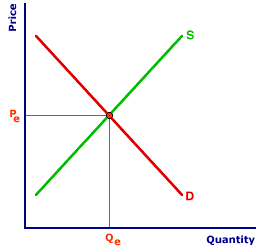
|
|
RIGHT TO WORK: A law preventing employers from making union membership a condition of employment. In other words, your boss can't forced you to join a union if you don't want to. There are two sides to this argument. On the one hand, workers should have the freedom to join a union or not based on the benefit to had from the union and perhaps their philosophical orientation towards unions. On the other hand, unions gain their strength by representing workers. Its negotiating position is hurt if it represents only a fraction of the workers. Moreover, any benefits a union gets for workers are enjoyed by its members (who pay dues) as well as nonmembers (who don't pay dues).
Visit the GLOSS*arama
|
|


|

|
                           INCREASING-COST INDUSTRY: A perfectly competitive industry with a positively-sloped long-run industry supply curve that results because expansion of the industry causes higher production cost and resource prices. An increasing-cost industry occurs because the entry of new firms, prompted by an increase in demand, causes the long-run average cost curve of each firm to shift upward, which increases the minimum efficient scale of production. The primary reason for an increasing-cost industry is that an increase in demand triggers higher production cost and an upward shift of the long-run average cost curve as new firms entering the industry bid up the prices of key resources. The entry of new firms into the software industry might, for example, bid up the wages paid to computer programmers. The entry of new firms into the home construction industry might bid up the price of lumber.First Demand The Increasing-Cost
Zucchini Industry |  |
The perfectly competitive Shady Valley zucchini market can be used to illustrate an increasing-cost industry. The original market equilibrium is presented in the exhibit to the right, with the supply curve S and the demand curve D. The market equilibrium price is Pe and the equilibrium quantity is Qe.The first step in identifying the long-run industry supply curve for an increasing-cost industry is with an increase in demand. Click the [Demand Shift] button to illustrate the shift of the demand curve to D'. Note that with the increase in demand, the market price of zucchinis increases to Pe' and the equilibrium quantity rises to Qe'. The higher price and larger quantity are achieved as each existing firm in the industry responds to the demand shock. The higher price that buyers are willing to pay induces existing firms to increase their quantities supplied as they move along their individual marginal cost curves. The market, as such, moves along the original market supply curve from one equilibrium point to a higher equilibrium point. However, the higher price leads to above-normal economic profit for existing firms. And with freedom of entry and exit, economic profit attracts kumquat, cucumber, and carrot producers into this zucchini industry. An increase in the number of firms in the zucchini industry then causes the market supply curve to shift. How far this curve shifts and where it intersects the new demand curve, D', determines that the zucchini market is an increasing-cost industry. The Supply ResponseEconomic profit induces non-zucchini firms to enter the zucchini industry. People like Dan the kumquat man begin producing zucchinis. As these new firms enter the zucchini industry, the market supply curve shifts rightward. The shift of the supply curve to S' can be seen with a click of the [Supply Shift] button. This new supply curve intersects the new demand curve, D', at the equilibrium price of Po and the equilibrium quantity of Qo.The key for an increasing-cost industry is how far the supply curve shifts. For an increasing-cost industry the shift is not very far. As new firms enter the industry, they bid up the resource prices and cause higher production cost. Perhaps the price of zucchini seeds rises. Maybe the price of zucchini fertilizer or zucchini shovels is higher. Whatever the actual resource price, the end result is that the long-run average cost curve shifts upward. The minimum efficient scale for a given perfectly competitive firm is now at a higher cost. This means that they cannot produce the extra quantity demanded by the zucchini buyers at the same per unit cost that had prevailed. The main point of interest is that the new equilibrium price is higher than the original. To display the resulting long-run supply curve for this increasing cost industry click the [Long-Run Supply Curve] button. The positive slope of the this long-run industry supply curve (LRS) indicates an increasing-cost industry.

Recommended Citation:INCREASING-COST INDUSTRY, AmosWEB Encyclonomic WEB*pedia, http://www.AmosWEB.com, AmosWEB LLC, 2000-2025. [Accessed: June 30, 2025].
Check Out These Related Terms... | | | |
Or For A Little Background... | | | | | | | | | | | |
And For Further Study... | | | |
Search Again?
Back to the WEB*pedia
|



|

|
|
Cyrus McCormick not only invented the reaper for harvesting grain, he also invented the installment payment for selling his reaper.
|

|
|
"I learned about the strength you can get from a close family life. I learned to keep going, even in bad times. I learned not to despair, even when my world was falling apart. I learned that there are no free lunches. And I learned the value of hard work. " -- Lee Iacocca
|

|
OBX
Oslo Stock Exchange (Norway)
|

|
|
Tell us what you think about AmosWEB. Like what you see? Have suggestions for improvements? Let us know. Click the User Feedback link.
User Feedback
|


|


